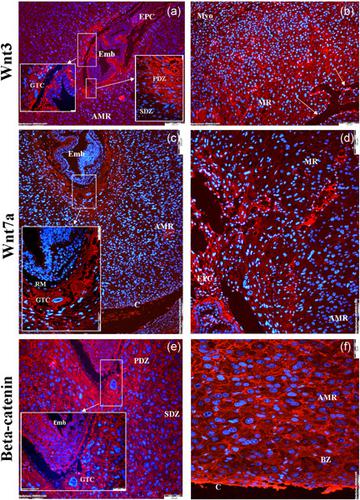当前位置:
X-MOL 学术
›
Mol. Reprod. Dev.
›
论文详情
Our official English website, www.x-mol.net, welcomes your
feedback! (Note: you will need to create a separate account there.)
Wingless ligands and beta-catenin expression in the rat endometrium: The role of Wnt3 and Wnt7a/beta-catenin pathway at the embryo-uterine interface.
Molecular Reproduction and Development ( IF 2.7 ) Pub Date : 2020-09-19 , DOI: 10.1002/mrd.23423 Celal Kaloğlu 1, 2 , Hüseyin E Bulut 2 , Rasim Hamutoğlu 2 , Ertan M Korkmaz 3 , Ozan Önder 2 , Tuğba Dağdeviren 2 , Merve N Aydemir 3
Molecular Reproduction and Development ( IF 2.7 ) Pub Date : 2020-09-19 , DOI: 10.1002/mrd.23423 Celal Kaloğlu 1, 2 , Hüseyin E Bulut 2 , Rasim Hamutoğlu 2 , Ertan M Korkmaz 3 , Ozan Önder 2 , Tuğba Dağdeviren 2 , Merve N Aydemir 3
Affiliation

|
Wnt/beta‐catenin signaling may play an essential role in endometrial decidualization, placentation, and the establishment of pregnancy. We investigate here the possible roles, immunolocalizations, and synthesis of the Wnt3, Wnt7a, and beta‐catenin proteins in the rat endometrium during the estrous cycle and early postimplantation period. Wnt3 and Wnt7a had a similar localization and dynamic expression relative to the endometrial stages. Wnt7a immunostaining was not limited only to the luminal epithelial cells, but also to strong stainings in the stromal and endothelial cells. Wnt3, Wnt7a, and beta‐catenin were highly synthesized and colocalized at the trophoblast‐decidual interface; and were more obvious in the primary decidual zone, the GTCs, and the ectoplacental cone. Beta‐catenin was strongly localized at the borders of the mature decidual cells; however, Wnt3 and Wnt7a immunolocalizations were decreased in those cells. As such, the immunolocalization of Wnt3, Wnt7a, and beta‐catenin shifted with decidualization and placentation. The expression level of Wnt3, Wnt7a, and beta‐catenin messenger RNAs increased in early pregnancy, and especially between Days 8.5 and 9.5. The dramatic changes in the expression of Wnt3, Wnt7a, and beta‐catenin observed during the early days of pregnancy and the estrous cycle may indicate their roles in decidualization, stromal cell proliferation, and trophoblast invasion.
中文翻译:

大鼠子宫内膜中的无翼配体和 β-连环蛋白表达:Wnt3 和 Wnt7a/β-连环蛋白通路在胚胎-子宫界面的作用。
Wnt/β-catenin 信号可能在子宫内膜蜕膜化、胎盘形成和妊娠建立中起重要作用。我们在这里研究了在动情周期和着床后早期大鼠子宫内膜中 Wnt3、Wnt7a 和 β-catenin 蛋白的可能作用、免疫定位和合成。Wnt3 和 Wnt7a 相对于子宫内膜阶段具有相似的定位和动态表达。Wnt7a 免疫染色不仅限于管腔上皮细胞,还包括基质和内皮细胞中的强染色。Wnt3、Wnt7a 和 β-catenin 高度合成并共定位于滋养层-蜕膜界面;并且在初级蜕膜区、GTC 和外胎盘锥中更为明显。β-连环蛋白强烈定位于成熟蜕膜细胞的边缘;然而,这些细胞中的 Wnt3 和 Wnt7a 免疫定位降低。因此,Wnt3、Wnt7a 和 β-catenin 的免疫定位随着蜕膜化和胎盘形成而发生变化。Wnt3、Wnt7a 和 β-catenin 信使 RNA 的表达水平在妊娠早期增加,尤其是在第 8.5 天和第 9.5 天之间。在妊娠早期和发情周期观察到的 Wnt3、Wnt7a 和 β-catenin 表达的显着变化可能表明它们在蜕膜化、基质细胞增殖和滋养层侵袭中的作用。Wnt3、Wnt7a 和 β-catenin 信使 RNA 的表达水平在妊娠早期增加,尤其是在第 8.5 天和第 9.5 天之间。在妊娠早期和发情周期观察到的 Wnt3、Wnt7a 和 β-catenin 表达的显着变化可能表明它们在蜕膜化、基质细胞增殖和滋养层侵袭中的作用。Wnt3、Wnt7a 和 β-catenin 信使 RNA 的表达水平在妊娠早期增加,尤其是在第 8.5 天和第 9.5 天之间。在妊娠早期和发情周期观察到的 Wnt3、Wnt7a 和 β-catenin 表达的显着变化可能表明它们在蜕膜化、基质细胞增殖和滋养层侵袭中的作用。
更新日期:2020-11-25
中文翻译:

大鼠子宫内膜中的无翼配体和 β-连环蛋白表达:Wnt3 和 Wnt7a/β-连环蛋白通路在胚胎-子宫界面的作用。
Wnt/β-catenin 信号可能在子宫内膜蜕膜化、胎盘形成和妊娠建立中起重要作用。我们在这里研究了在动情周期和着床后早期大鼠子宫内膜中 Wnt3、Wnt7a 和 β-catenin 蛋白的可能作用、免疫定位和合成。Wnt3 和 Wnt7a 相对于子宫内膜阶段具有相似的定位和动态表达。Wnt7a 免疫染色不仅限于管腔上皮细胞,还包括基质和内皮细胞中的强染色。Wnt3、Wnt7a 和 β-catenin 高度合成并共定位于滋养层-蜕膜界面;并且在初级蜕膜区、GTC 和外胎盘锥中更为明显。β-连环蛋白强烈定位于成熟蜕膜细胞的边缘;然而,这些细胞中的 Wnt3 和 Wnt7a 免疫定位降低。因此,Wnt3、Wnt7a 和 β-catenin 的免疫定位随着蜕膜化和胎盘形成而发生变化。Wnt3、Wnt7a 和 β-catenin 信使 RNA 的表达水平在妊娠早期增加,尤其是在第 8.5 天和第 9.5 天之间。在妊娠早期和发情周期观察到的 Wnt3、Wnt7a 和 β-catenin 表达的显着变化可能表明它们在蜕膜化、基质细胞增殖和滋养层侵袭中的作用。Wnt3、Wnt7a 和 β-catenin 信使 RNA 的表达水平在妊娠早期增加,尤其是在第 8.5 天和第 9.5 天之间。在妊娠早期和发情周期观察到的 Wnt3、Wnt7a 和 β-catenin 表达的显着变化可能表明它们在蜕膜化、基质细胞增殖和滋养层侵袭中的作用。Wnt3、Wnt7a 和 β-catenin 信使 RNA 的表达水平在妊娠早期增加,尤其是在第 8.5 天和第 9.5 天之间。在妊娠早期和发情周期观察到的 Wnt3、Wnt7a 和 β-catenin 表达的显着变化可能表明它们在蜕膜化、基质细胞增殖和滋养层侵袭中的作用。











































 京公网安备 11010802027423号
京公网安备 11010802027423号